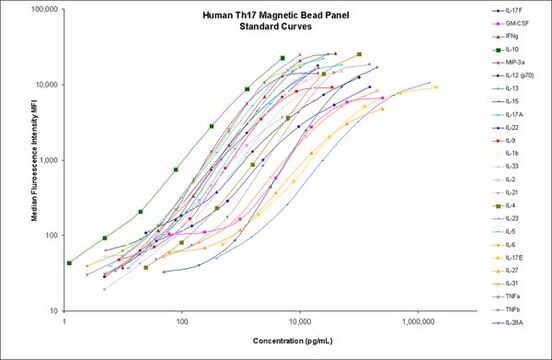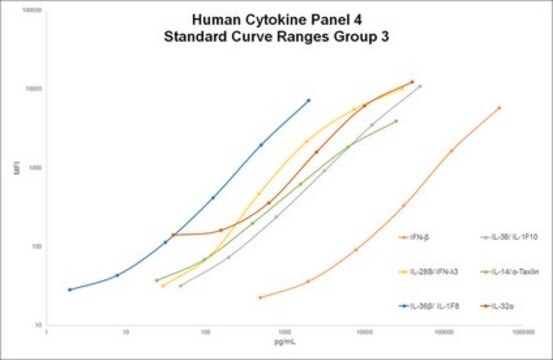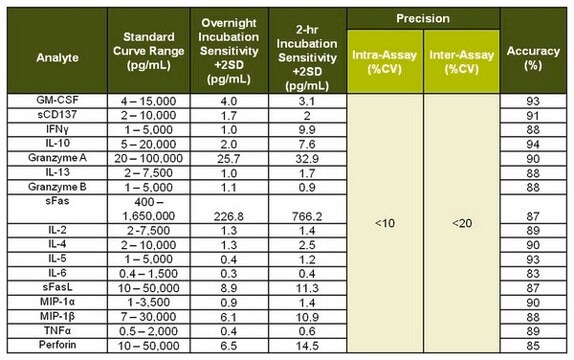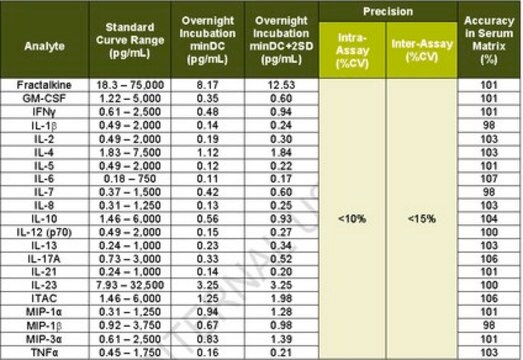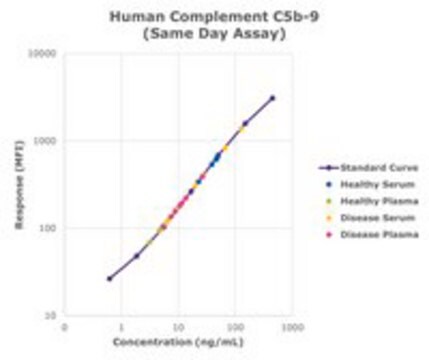HCD8MAG-15K
MILLIPLEX® Human CD8+ T Cell Magnetic Bead Panel - Immunology Multiplex Assay
Simultaneously analyze multiple cytokine and chemokine biomarkers with Bead-Based Multiplex Assays using the Luminex technology, in human serum, plasma and cell culture samples.
Synonyme(s) :
Human CD8 T cell cytokine panel, Human cytokine multiplex kit, Luminex® human cytokine immunoassay, Millipore human cytokine panel
About This Item
Produits recommandés
Niveau de qualité
Espèces réactives
human
Fabricant/nom de marque
Milliplex®
assay range
standard curve range: 0.4-1,500 pg/mL
(IL-6)
standard curve range: 0.5-2,000 pg/mL
(TNFα)
standard curve range: 1-3,500 pg/mL
(MIP-1α)
standard curve range: 1-5,000 pg/mL
(Granzyme B)
standard curve range: 1-5,000 pg/mL
(IFNγ)
standard curve range: 1-5,000 pg/mL
(IL-5)
standard curve range: 10-50,000 pg/mL
(Perforin)
standard curve range: 10-50,000 pg/mL
(sFasL)
standard curve range: 2-10,000 pg/mL
(IL-4)
standard curve range: 2-10,000 pg/mL
(sCD137)
standard curve range: 2-7,500 pg/mL
(IL-13)
standard curve range: 2-7,500 pg/mL
(IL-2)
standard curve range: 20-100,000 pg/mL
(Granzyme A)
standard curve range: 4-15,000 pg/mL
(GM-CSF)
standard curve range: 400-1,650,000 pg/mL
(sFas)
standard curve range: 5-20,000 pg/mL
(IL-10)
standard curve range: 7-30,000 pg/mL
(MIP-1β)
Technique(s)
multiplexing: suitable
Méthode de détection
fluorometric (Luminex xMAP)
Conditions d'expédition
wet ice
Description générale
The Luminex® xMAP® platform uses a magnetic bead immunoassay format for ideal speed and sensitivity to quantitate multiple analytes simultaneously, dramatically improving productivity while conserving valuable sample volume.
Panel Type: Cytokines/Chemokines
Spécificité
Application
- Analytes: GM-CSF, sCD137, IFNγ, sFas, sFasL, Granzyme A, Granzyme B, IL-2, IL-4, IL-5, IL-6, IL-10, IL-13, MIP-1α, MIP-1β, TNF-α, Perforin
- Recommended Sample type: serum, plasma or tissue/cell lysate and culture supernatant
- Recommended Sample dilution: Neat
- Assay Run Time: Overnight
- Research Category Inflammation & Immunology
Caractéristiques et avantages
Stockage et stabilité
Autres remarques
Informations légales
Clause de non-responsabilité
Mention d'avertissement
Danger
Mentions de danger
Classification des risques
Acute Tox. 4 Dermal - Acute Tox. 4 Inhalation - Acute Tox. 4 Oral - Aquatic Chronic 2 - Eye Dam. 1 - Skin Sens. 1 - STOT RE 2
Organes cibles
Respiratory Tract
Code de la classe de stockage
10 - Combustible liquids
Classe de danger pour l'eau (WGK)
WGK 3
Certificats d'analyse (COA)
Recherchez un Certificats d'analyse (COA) en saisissant le numéro de lot du produit. Les numéros de lot figurent sur l'étiquette du produit après les mots "Lot" ou "Batch".
Déjà en possession de ce produit ?
Retrouvez la documentation relative aux produits que vous avez récemment achetés dans la Bibliothèque de documents.
Notre équipe de scientifiques dispose d'une expérience dans tous les secteurs de la recherche, notamment en sciences de la vie, science des matériaux, synthèse chimique, chromatographie, analyse et dans de nombreux autres domaines..
Contacter notre Service technique
